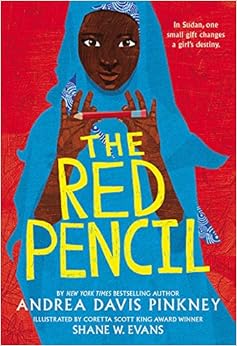 The Red Pencil
The Red PencilAndrea Davis Pinkney
Shane W. Evans, Illustrator
Little Brown, 2014 308 pgs.
Grades 4-8
Narrative Poetry, Historical Fiction
Amira is a twelve-year-old girl living in a rural community in the Dafar region of Sudan. Life is difficult, yet predictable, and she is happy with the cycle of life and her loving family. Conflict arises as word spreads of the Janjaweed, soldiers who destroy everything in their path. The ups and downs of African farm life are portrayed in poetry, as Amira's best friend moves to the safety of the city and Amira gains more responsibilities. The worst is realized as the Janjaweed blows through town, murdering half the population, including Amira's father, and burning the crops, house, and life stock. Amira, her mother, sister and the surviving members of the village travel by night to a refugee camp. Now, poems trace the life in the camp as Amira is struck dumb by her grief and the family ekes out a bitter existence. Hope is found in a slim red pencil, which Amira uses to draw her story and slowly heal. Always experiencing a thirst for knowledge in a culture where education is costly and not wasted on girls, Amira now becomes unsettled. Finally, she finds the courage within herself to leave the camp in the dead of night to journey to the city in order to attend school. Not knowing the direction to go, the plan seems hopeless until she is joined by a family friend, who recognizes her gifts and accompanies Amira on the path leading to her dreams.
I have often said, "everything I know about the world I have learned from reading children's books". This sentiment continues as I learned about the stories and conditions of refuges of the Dafar conflict. I discovered that I know embarrassing little of the situation and was grateful to Pinkney for educating me in a manner that my ADD brain could process. Pinkney's poetry is beautiful, as well as narrative. She tells the story in an approachable way and, through the vehicle of her poetry, is honest, yet digestible. We see the story through Amira's eyes; both through the poems and the beautiful line drawings contributed by Shane W. Evans. The drawings help illustrate what Amira is seeing and feeling, while also connecting us to her gift of drawing. The Red Pencil draws attention to the conflict in Dafar, while also exploring other issues; such as lack of education in developing countries and lack of rights for women, conditions of refugee camps, the power of art to heal, and giving a voice to the voiceless. This a beautiful and important book and one that I'm better for reading. My only complaint is that I doubt children will pick it up to read on their own for pleasure. I didn't buy it for my library, predicting that it wouldn't circ. If it wins a Newbery or Newbery honor I will buy it, because that award will guarantee a readership. The Red Pencil will be best suited for school use, particularly now with the trend of learning through literature. I would encourage the inclusion of this book into the social studies curriculum and hope that teachers and school librarians will promote the book to their students. Meanwhile, we'll wait and see what happens when the Newbery Awards winners are revealed next month.
No comments:
Post a Comment